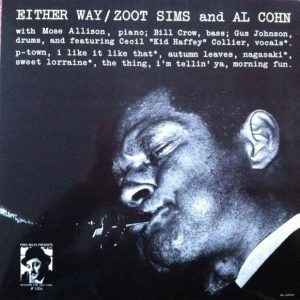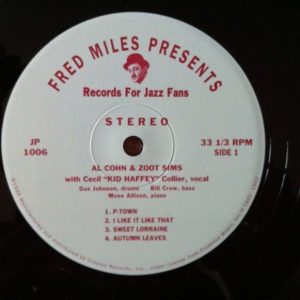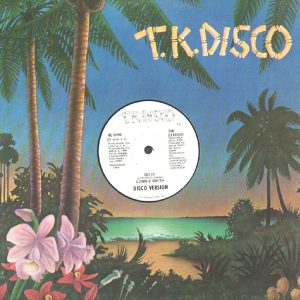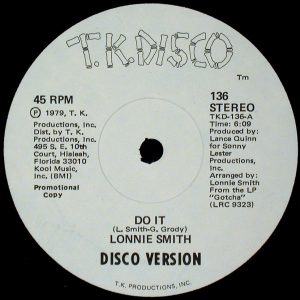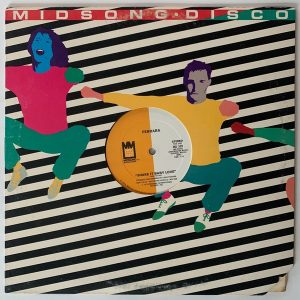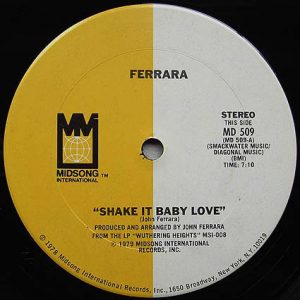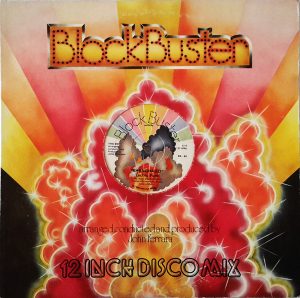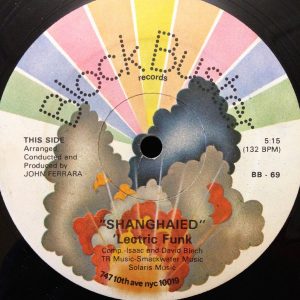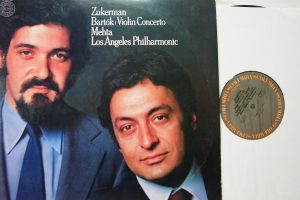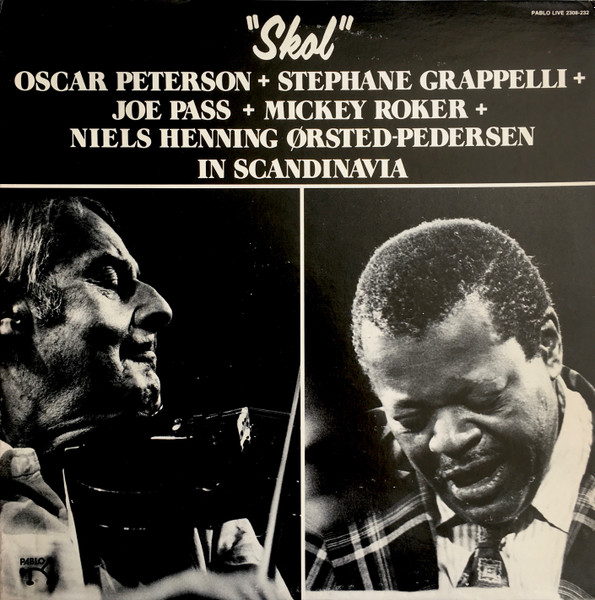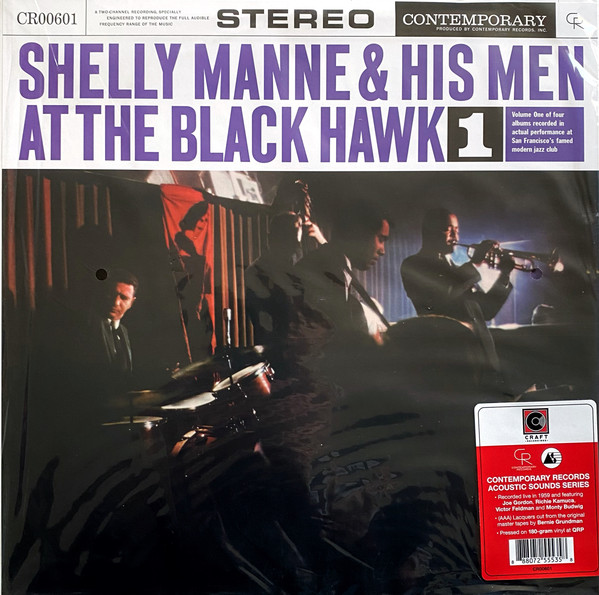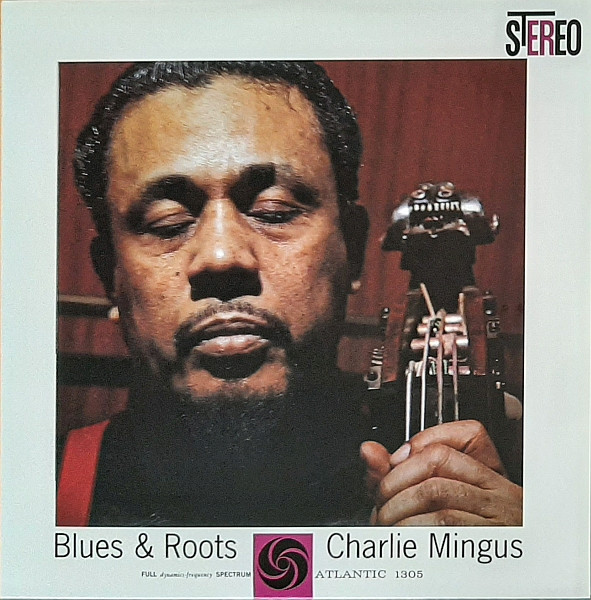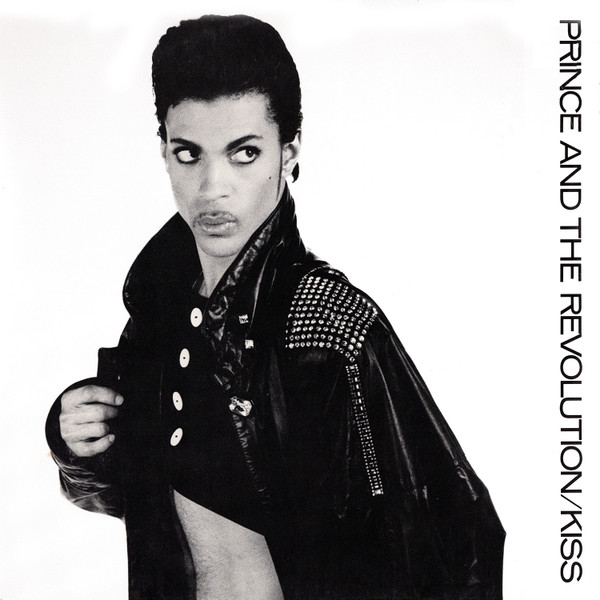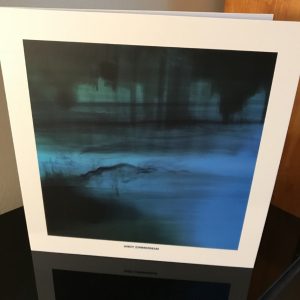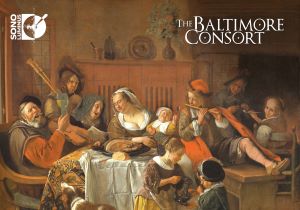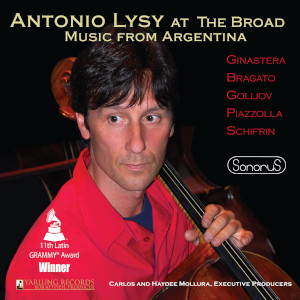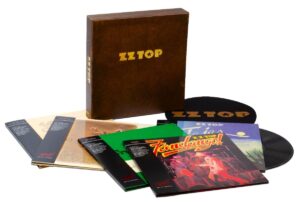This is an ongoing project by Claude Lemaire of Soundevaluations
126. Zoot Sims and Al Cohn with Cecil Collier, Either Way. Fred Miles – FM-1 (1961), Classic Records JP 1006 (1998) 33 1/3 rpm. Genre: jazz, small combo swing, cool jazz, West Coast, jump blues.
Tenor saxophonists Zoot Sims and Al Cohn head a cool swinging rhythm section of lesser-known cats, consisting of Count Basie veteran Gus Johnson on drums, Bill Crow on bass, and "Old Grand Happy" aka Mose Allison on piano, with Cecil "Kid Haffy" Collier contributing vocals on three of the eight tracks. Sims and Cohn craft three compositions to the track list, of which includes interesting takes on popular jazz standards "Sweet Lorraine," "Autumn Leaves," and "Nagasaki." Born barely a month apart in 1925, and highly influenced like so many by tenor legend Lester Young—first through the Count Basie Orchestra, and on his own—John Haley Sims and Alvin Gilbery Cohn would start a long musical relationship starting in 1948 within Woody Herman's band—among which featured renowned saxophonist Stan Getz—closely followed in Artie Shaw's band. These tight fit associations of playing and practicing together night after night, no doubt deepened the strong swinging bond and shared chemistry. Recorded in February 1961 at British bassist Peter Ind's studio in New York City—who I assume engineered the sessions—the sound is simply exquisite on all fronts: even tonal balance, beautiful warm mids, great tenor presence, appropriate dynamics, non-fatiguing, mildly soft top end that makes you turn up the volume. A strong solid central image of the rhythm section is flanked by the two tenors panned out, perfectly juxtaposing their tight swinging unison phrasings, and creative counter melodies. I do not have the original LP release pressed by RCA Records in Rockaway, but this Classic Records reissue, remastered and cut by Bernie Grundman is superb from start to finish, and one of my favorites from him; sounding warmer than his average cuts, very organic, and more what I'd expect from a Kevin Gray signature sound. Sims and Cohn are at the top of their game, showing no weak moments either way. They sum it up best this way: "Yes, a kind of telepathy does happen, and pretty soon you know what the other is thinking... and it just comes out." "We learned a lot from each other."
127. Lonnie Smith, "Do It." T.K. Disco – 136 (1978), 12", 45 rpm, promo. Genre: funk, jazz-funk, funky disco.
Better known as a soul-jazz-funk B3 practitioner who once was part of the George Benson Quartet, Lonnie Smith—like many others in the late 1970s—cozied up to the disco craze by lending it a strong funk flavor. "Do It" digs down to a hurried-tempo, dirty, funky type o' thing—think Prince's "Controversy" [Warner Bros. K 17866] meets Kool and the Gang's "Open Sesame" [De-Lite Records DSD 586] going at it at max-pitch for six minutes. From the get-go, the intro rushes into a descending scale stormlike staccato run, similar to pumping the breaks on an icy road, and heavily borrowed from The Trammps' "Disco Inferno" intro [Atlantic SD 18211]. It is produced by Lance Quinn, known for his guitar contributions on numerous disco sessions such as those from Gloria Gaynor and Carol Douglas. The short riff bursts from the brass section are as rapid and tight as the J.B.'s in action. Firing on all cylinders and cut at a hot level, this is the kind of track that will not pass well on typical tower-slim audiophile speakers where the high treble energy in the grooves may aggress some listeners or cause minor ear fatigue. On the other hand, played on an efficient wide baffle, horn type, balanced speaker, the sound is meaty, chunky, and crunchy, creating plenty of physicality. There is some apparent compression precluding a perfect performance, but recommended nevertheless for the noted qualities above, and sheer fun factor. It will also put to the test your cartridge-tonearm tracking capabilities. The cleaner, the better.
128. Ferrara, "Shake It Baby Love"/"Love Attack." Midsong International – MD 509 (1979), 12", 33 1/3 rpm. Genre: disco, Hi-NRG, minor Euro disco and proto-Italo leanings.
Released in March 1979, these two equally interesting, highly energetic tracks share similitudes, and as such mix well together if you happen to own a second copy. Produced, arranged, and written by John Ferrara—there is very little information on the latter unfortunately. Although side B's "Love Attack" received more air-club play, both were cut from the same cloth, and extracted from Ferrara's only album—Wuthering Heights [Midsong International MSI 008]. Recorded by Bill Sheniman, Burt Szerlip, and Neil Dorfsman at Power Station in New York City, and remixed by Bernard Fox at Bernard Fox Studios, the sound is uniformely excellent with fine full frequency tonal balance, supported by a driving, dynamic bass, and percussive pace. The heavy emphasis on the synth and keyboards plus the rapid panning handclaps by "Clear Sky" heard at multiple intervals during "Love Attack," give it an exciting edge and Hi-NRG flavor whereas side A's track, pushes more the quick-succession staccato kick rhythm effect, and leans more towards Euro with brass and reeds taking more importance in the arrangements. Also there seems to be a recurring melodic line mildly borrowing from The Four Tops' 1966 hit "Standing in the Shadows of Love" [Motown MS 660]. Although not credited on this 12-inch single, the album which includes these two songs does credit the following singers: Angie Bofill, Curt Richards, Diane Wilson, Irene Datcher, and Miles McMillen. Note that both songs are mainly instrumental with sparse female-dominated chorus intersperse throughout, and suffer from some form of repetition along the lines of Silver Convention's main hits: "Save Me," and "Fly, Robin, Fly" [Jupiter Records 89 100 OT], and "Get Up and Boogie" [Midland International BKL1-1369]. Fun all the same.
129. 'Lectric Funk, "Shanghaied"/"Sweet Sensations." Block Buster Records – BB-69 (1979), 12", 33 1/3 rpm. Genre: disco, Hi-NRG, minor new wave and electro elements.
Also produced, arranged, and conducted by John Ferrara, this 12-inch single came out around August 1979, as the disco craze was now starting a steep decline, due in part to the famous Disco Demolition Night of July 12, just a few weeks prior, and the rapid rise of new wave sweeping the airwaves and clubs–both events disrupting the normal flow of what had been a long, slow, steady ascension since its beginning six or so years ago. Another "one-hit wonder" formation, 'Lectric Funk forwent the latter style completely, concentrating instead on a heavyish-hard Hi-NRG disco, dabbling its feet in new wave-electronic directions. With its unforgettable "1-1, 2-2, 3-3, 4-4" intro count, "Shanghaied" showcased a galloping reverberated beat that guaranteed to galvanize the clubbers to the dancefloor every night. Written by David and Isaac Blech, the song's propulsive pounding rhythm is a sure way to test your sound system's fun factor—if you are not tapping your foot, then you are in serious need for a prat wake-up call! There are no singing credits but the male vocals are quite good for the genre with the distinctiveness of juxtaposing two different registers—mainly a normal middle one plus a much lower one coming on at the end of some verses and mixed in the chorus. Side two's "Sweet Sensation" is less well known but as worthy on musical and sonic grounds with a wide and deep soundfield including exciting panning effects. Both songs are very punchy, dynamic, and tight in the 80 to 100Hz kick region, and even slam in the upper bass on an efficient club-like speaker. The thin vinyl was pressed by Sound Makers in Brooklawn/Westville, New Jersey. There is also a red vinyl edition which I have not heard to compare with.
130. Bartók, Violin Concerto. Zukerman, Mehta, Los Angeles Philarmonic. Columbia Masterworks – M 35156 (1979), 12", 33 1/3 rpm. Genre: classical, modern.
Born in 1881, one year prior to Igor Stravinsky, both gentlemen garner high praise, commanding utmost respect for their works in the modern era, and are rightly considered two of the most important composers of the first half of the 20th century. While the latter shared history with many famous Russian counterparts and is best known through three colorful–and controversial for its time—ballets, Humgary's Béla Bartók barely benefited from Franz Liszt as national torch bearer, and is best remembered by integrating musical nationalism through Hungarian folk forms, and disrupting the diatonic scale such as applied in polymodal chromaticism. In a nutshell, he combined certain elements of Shoenberg's strict twelve-tone technique—where the Austrian's tone sequence was rigidly structured—with what Bartók called peasant music or rather Eastern European folk; and in doing so, was able to retain tonality through twelve-tone themes, which are normally atonal in nature, and harder to approach for many listeners, making his music a tad less intimidating. A perfect example of this is his Violin Concerto (No.2, BB117), a mature, three-movement with variations piece, written in 1938–two years after travelling to Turkey to study Turkish folk music, as well composing his most famous Music for Strings, Percussion and Celesta. This was during a period of great uncertainty, and fear for the composer, considering the rapid rise of fascism in Europe, his strong opposition to the Nazis, and culminating in his decision to migrate to the States in New York City in October 1940. It is perhaps quite fitting that Israeli-born violinist Pinchas Zukerman—whose Jewish parents were Holocaust survivors, taught him to play at age eight, and eventually enrolled into NYC's Julliard School in 1962—would get to interpret and record this composer's creations, exactly four decades later. Interestingly, Indian-born conductor Zubin Mehta was also first taught violin and piano by his father—who had studied under violinist Ivan Galamian in New York, which also tutored Zukerman and Itzhak Perlman. Mehta led the Los Angeles Philharmonic as Music Director from 1962 to 1978, becoming at 26, the youngest director in that prestigious post. This Columbia Masterworks release is dated 1979, so I'm guessing the recording must have been done within the previous year, given the maestro's departure from LAP in 1978 for the post of Principal Conductor of the New York Philharmonic, which he held until 1991. Unfortunately there is no information nor engineering credits whatsoever. That being said, the sound is supremely sweet, extended in the treble, and highly dynamic with a very low noise-floor, exciting yet non-fatiguing, vast in all three dimensions, and arguably even superior—at least in the top end—to the best Heifetz-RCA Living Stereo, and Red Seal originals or Classic Records remasterings, with less grain and more finesse.
For more from Claude Lemaire go to his blog...
http://soundevaluations.blogspot.ca/




